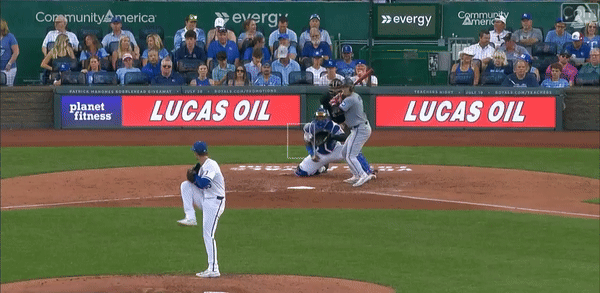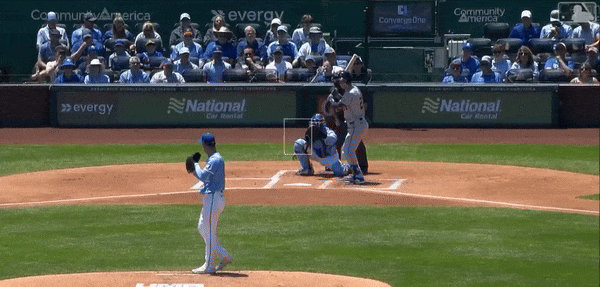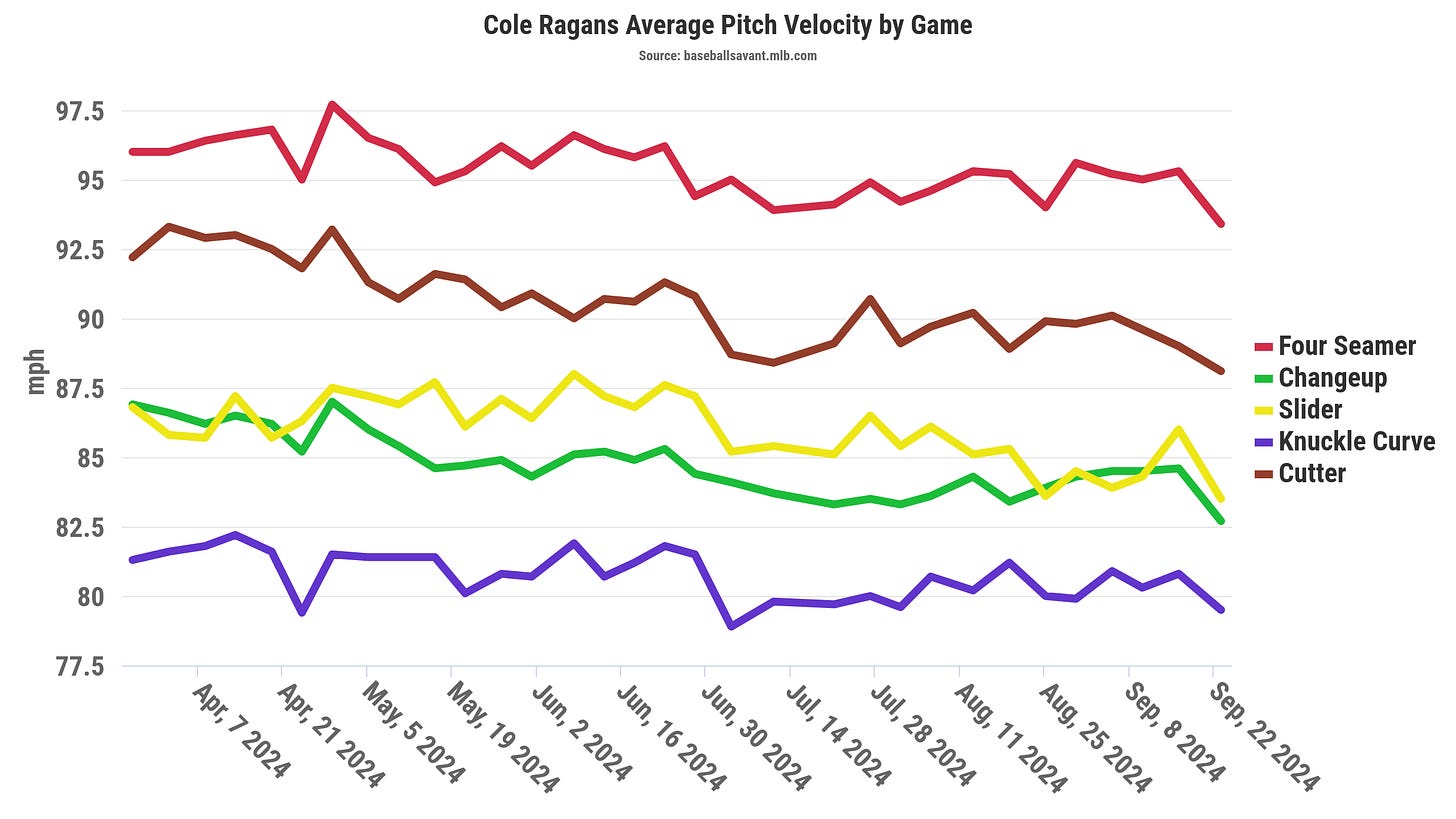The Royals reward their ace
Cole Ragans is set to earn $13.25 million over the next three seasons.
What did you do for your significant other on Valentine’s Day? Some flowers? A nice dinner? Perhaps a corporate greeting card?
The Royals celebrated by asking Cole Ragans to “be theirs” for the next three years at a princely sum of $13.25 million.
Yeah, forget the flowers…the Royals and Ragans won Valentine’s Day.
For Ragans, the courtship was abbreviated. The Royals and his agents started talking in earnest on Wednesday. By Friday, the deal was done. Though Ragans and the Royals were still tied to each other even had this extension not been reached, Ragans is thrilled.
It's an unbelievable group of people from the front office to the fans, to my teammates. It's just a great group of guys. My wife loves it.
You know, it felt like home really quickly and I feel like that's not the case everywhere. So it's been special. Like I said, I love it here.
Ragans views his deal as something that is beneficial for both the player and the club.
Yeah, I mean I think it gives me a little security. It gives them, you know, they kind of know what's on the books and that kind of stuff so we can, you know, get some other guys if that's what they want to do, and try to put the best team on the field to win. You know, that's our end goal is to win a championship.
I’ll have more on this in a moment, but let’s just say that I agree with what Ragans is saying.
And let’s remember this before we get any further…The Royals have control of Ragans for the next four seasons. This contract changes nothing as far as that. It simply removes what would’ve been annual negotiations between the two sides and a potential arbitration hearing had they not been able to come to terms ahead of the 2026 and 2027 seasons. They left one arbitration year—his third and final one—out. Again, more on that below.
According to Mark Feinsand, Ragans’ contract breaks down like this:
2025 - $1 million
2026 - $4.5 million
2027 - $7.5 million
There is also a $250,000 signing bonus and an escalator that will push his 2027 salary to $8 million if he wins the Cy Young award in either of the next two seasons.
(The low dollar amount for 2025 is because Ragans is not yet eligible for arbitration. In this situation, a player rarely makes what he is truly worth. Blame the system, not the player or the team.)
This is an incredibly unique contract and, to me, another example of how JJ Picollo and his staff are operating without adhering to the norms of the business of baseball. They are doing what is right for the organization and the player.
The contract is unique because extensions like this usually cover all three arbitration years. Or maybe the final two seasons ahead of the player being eligible for free agency. Or maybe one or two years of free agency are bought out. In the case of Ragans, he will be eligible for arbitration ahead of the 2028 season. The Royals hold Ragans’ rights for the next four years, no matter the length of the contract extension. The two sides just locked in the dollars for the next three years. Ragans gets some security. The Royals get some certainty.
This also doesn’t preclude the Royals and Ragans’ representation from talking about a longer-term deal. Here’s what Picollo had to say about that:
I think the best thing about this is it doesn't remove the ability to talk about (a long-term deal) in the future because we still have a long time. He will be in a Royals uniform for four more years. And we know that.
And that was something that after we had come to an agreement, I shared with Cole, you know, this doesn't mean we're closing the door in anything long term. This just gives you the ability to have peace of mind, you know, every day when you come to the field.
So don't read into this at all that we're not thinking about anything long-term. That's certainly something we'll consider.
As Ragans alluded to, this deal feels very much a win-win. It also seems as though Ragans and his agents were a bit surprised that the Royals wanted to do this. But once the initial offer was made, things moved quickly.
Picollo, again:
So internally we've been discussing it for some time, and we just thought the right time for it was the start of spring training. You know, we thought through it very carefully. And again, from our end, what are the pros and cons? You know, there's always some risk involved in any type of guaranteed contract. But we got to a point where we were comfortable bringing it to his representation.
And just from the initial response, they were happy to hear from us.
And it was probably less than 48 hours. You know, when you're trying to arrive at numbers in a situation like this, it's really not that difficult. It's either going to be a yes or a no. And if it's a no, no big deal. You just move on and, you know, no harm, no foul. And Cole goes out and pitches well and earns his money. But in this case, when we got a positive response, we were able to put it together very fast.
What made these negotiations fairly straightforward is the fact the deal covers the upcoming season, plus those first two years where Ragans would be arbitration-eligible. Looking at comps for what would cover Ragans’ first year of arbitration (2026), the top starting pitcher as an Arbitration-1 guy was Boston’s Tanner Houck who signed a deal for $3.95 million. Ragans bests that, but then again, he’s a better pitcher than Houck. Expand the net and one of the higher Arb-1 guys of the last 10 years was Dylan Cease ahead of the 2023 season. He signed for $5.7 million. Cease had been worth 4.5 and 4.4 fWAR in the two seasons before. The seasons prior, Corbin Burnes pitched for $6.5 million as an Arb-1 guy. He was coming off a season where he posted a 7.5 fWAR and won the Cy Young in the NL.
Ragans finished last year with a 4.9 fWAR. I think that makes his Arb-1 a fair deal given that he doesn’t possess the track record of Cease nor the heights of Burnes. Could Ragans have made more in 2026? Perhaps, but these deals are always where the player has to give a little to gain fiscal security. It’s not like he’s leaving multiple millions on the table. He’s within the range.
A more immediate comp would be George Kirby, who as a super-two, eligible for arbitration for the first time, will be earning $4.3 million next season. He was worth 4.2 fWAR in 2024.
For his second year of arbitration eligibility, Ragans is set to earn $7.5 million ($8 million if he wins a Cy Young before that). The ceiling for Arb-2 starting pitchers seems to be in the neighborhood of $10 million. Tarik Skubal will make $10.15 next year. Last season, Arizona’s Zac Gallen earned a shade over $10 million after posting 5.2 fWAR in 2023. And in 2022, both Burnes and Shane Bieber made just over $10 million as Arb-2 starters.
Again, it’s important to note, that those are pitchers who went through the contract process to get to those numbers and were coming off stellar seasons. Ragans may be leaving a million or two on the table for his Arb-2 season, but again, he’s locking in some security. You have to give a little to get something in return.
Why now? Why make a move to lock a player into a salary for the next three seasons when the Royals didn’t have to do it? They just could’ve renewed his contract for this season and then rolled on to the arbitration years. Of course, there was the cost certainty that has been mentioned. A small market team like the Royals can better set their player acquisition goals when they know the amount of dollars they’re committing to a particular player.
Picollo, however, was thinking about something in addition to that.
I think sometimes you got to think about the psyche of the player. You know, Cole's very grounded in who he is. He's very prepared. We know he's going to have a great year. But, you know, things like this can weigh on people's minds. And not that he ever expressed anything like that, but now that he can go to bed every night with peace of mind that there's security. He just got to pitch. And that's really ultimately what we want him to do.
The Royals approached this as if Regans could be looking at his 2025 season like a free agent walk year. Not that he was going to hit the open market, but rather that the pressure would be on him to maximize his value as he was getting ready to become eligible for arbitration. I can certainly see that as a factor that could weigh on a player. We also know that arbitration is less about WAR and more about wins. It’s about baseball card numbers and being in the top ten in something like strikeouts and how many of your starts did your team win and things like that.
Even though Ragans does well in all areas, the Royals made a conscious effort to remove pressure from their most important starting pitcher.
The Royals front office continues to impress.
The Ragans for Aroldis Chapman deal was a masterstroke. One of those rare trades that, in hindsight, reveals it to be a building block to not just an improved rotation, but to push the team into contention. I don’t think I’ll ever tire of writing about it. Picollo was asked if he envisioned the success Ragans has found since joining the Royals:
I wish I could tell you yes, but I'd be lying. I mean, we knew we were acquiring a starting pitcher that had a lot of ability that our scouts like, that from an analytic piece, we thought he was moving in the right direction for various reasons. But there are things that happen along the way that we couldn't have predicted.
One, knowing the player better. We know him better now. But the other thing is the addition of a slider, what we could do with him potentially with our staff, but more of that was his desire to throw a slider. All of those things came together pretty quickly. So is he what we hoped and more? Yeah, he is.
Going back to that trade in the moment, we liked Cole Regans enough that it was the right time to acquire a player. We didn't know what the rest of the trade deadline was going to bring. So we could have hedged a little bit and try to get more, but we were very comfortable in the return. And at that time, we knew we had to start building out our rotation in a way that was going to be performing better than we were in the moment.
So he was one piece at the time and it's turned out to be a good move for us.
About that slider…what a filthy pitch.
Last year, opponents hit .210 against the Ragans slider with a .305 slugging percentage. He got a whiff on over a third of the swings batters took against that offering. And 44 percent of all plate appearances that ended on a Ragans slider ended up as a strikeout. Somehow the pitch didn’t grade as well as far as Statcast’s Run Value (it was a -6), but when you fold this pitch in with his four-seamer, his change and his curve, it’s just another wrinkle that makes him so difficult to beat.
Maybe instead of the slider down and in, you prefer a GIF of a changeup that literally floats away from a right-handed batter.
Ragans threw the changeup primarily to righties and you can certainly see why. Overall, it was his second-best pitch last year according to Statcast. He limited hitters to a .183 BA and a .280 slugging percentage on the change. Nearly half the swings on the pitch were misses and when hitters made contact, they rarely barreled the pitch. The average exit velocity on the Ragans change was just shy of 82 mph.
The best pitch that Ragans had in his arsenal last year was his four-seamer. Witness.
What is a hitter supposed to do with that?
I’ve given you three GIFs of three different pitches in three different locations. With three of the same results. The man is lethal on the mound.
Those location heat maps tell the story. Three pitches, three velocities, in three different locations. Good luck.
Just because we’ve made it nearly 2,000 words into this post and haven’t yet mentioned Ragans’ injury history does not mean it’s been forgotten. Or that it’s not important. We are all familiar with the Ragans story and his journey from two Tommy John surgeries to ace of the Royals staff. After tearing his UCL and undergoing his first TJ procedure in 2018, it ultimately failed before he was able to pitch in a competitive game. He had another surgery in 2019. He didn’t toss an inning of professional ball from 2018 to 2020.
As such, there’s always a concern when Ragans takes the ball. The fact is, he wasn’t throwing as hard in the second half of the season as he was in the first.
That’s not to say that he was injured or that he’s heading to another surgery. The risk is there for every pitcher but it’s an elevated one for a pitcher who has already had the procedure.
No one mentioned it, but for the Royals to give this kind of guarantee—really any kind of guarantee—Ragans needed to have a clean bill of health. I think it’s safe to assume his medicals all checked out.
It will be interesting to see where Ragans’ velocity is to open the 2025 season. Will it be first-half velocity on the four-seamer that was around 96 mph? Or will it be closer to his second-half velocity of around 94 mph? Any drop in velocity is suboptimal, but given how Ragans uses all of his pitches, he was certainly able to navigate that last year.
The Royals have locked up their most important pitcher to a guaranteed contract over the next three seasons. It gives the team cost certainty moving forward as they set the budgets for 2026 and 2027 and it gives Ragans plenty of stability that, during those dark rehab days six years ago, he could only dream of.
It’s a good move for the Royals. It’s a good move for Regans. It’s the kind of baseball deal that you like to see.















I love the part where JJ talks about his psyche and knowing he is secure and just has to pitch. Taking away as many "off field" distractions as possible is a big boost to the player being able to focus.
I think of the final year of Tyrann Mathieu with the Chiefs and how poorly that went when his concern was on a new contract and not on the job.
Maybe this is one way the Royals win in the margins. Lock up guys they know are part of the future to keep their focus on the sport.
Not only does this deal build good will between the team the the player, which impacts the ability to sign him long term (provided he stays healthy), but it sends a strong signal to young guys in the system and free agents that the Royals are a class organization. While they can't compete in dollars with larger-market teams, if they can win on the margins like this, maybe they can be in contention consistently. BTW, maybe you could contrast this approach with that of the Rays, which have the reputation of "using up" their pitchers and then trading them before they get paid?